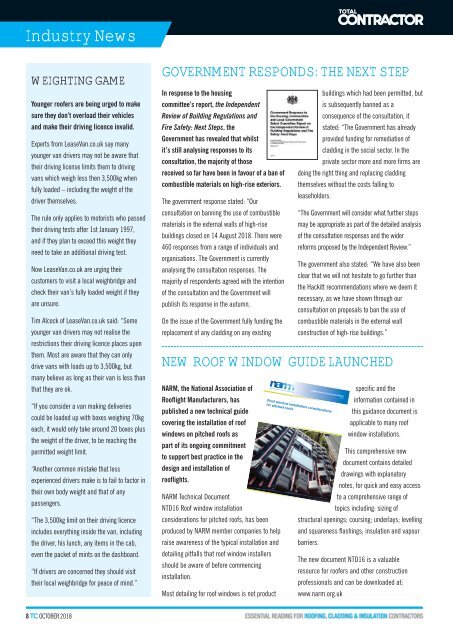October 2018
Create successful ePaper yourself
Turn your PDF publications into a flip-book with our unique Google optimized e-Paper software.
Industry News<br />
WEIGHTING GAME<br />
Younger roofers are being urged to make<br />
sure they don’t overload their vehicles<br />
and make their driving licence invalid.<br />
Experts from LeaseVan.co.uk say many<br />
younger van drivers may not be aware that<br />
their driving license limits them to driving<br />
vans which weigh less then 3,500kg when<br />
fully loaded – including the weight of the<br />
driver themselves.<br />
The rule only applies to motorists who passed<br />
their driving tests after 1st January 1997,<br />
and if they plan to exceed this weight they<br />
need to take an additional driving test.<br />
Now LeaseVan.co.uk are urging their<br />
customers to visit a local weighbridge and<br />
check their van’s fully loaded weight if they<br />
are unsure.<br />
Tim Alcock of LeaseVan.co.uk said: “Some<br />
younger van drivers may not realise the<br />
restrictions their driving licence places upon<br />
them. Most are aware that they can only<br />
drive vans with loads up to 3,500kg, but<br />
many believe as long as their van is less than<br />
that they are ok.<br />
“If you consider a van making deliveries<br />
could be loaded up with boxes weighing 70kg<br />
each, it would only take around 20 boxes plus<br />
the weight of the driver, to be reaching the<br />
permitted weight limit.<br />
“Another common mistake that less<br />
experienced drivers make is to fail to factor in<br />
their own body weight and that of any<br />
passengers.<br />
“The 3,500kg limit on their driving licence<br />
includes everything inside the van, including<br />
the driver, his lunch, any items in the cab,<br />
even the packet of mints on the dashboard.<br />
“If drivers are concerned they should visit<br />
their local weighbridge for peace of mind.”<br />
GOVERNMENT RESPONDS: THE NEXT STEP<br />
In response to the housing<br />
committee’s report, the Independent<br />
Review of Building Regulations and<br />
Fire Safety: Next Steps, the<br />
Government has revealed that whilst<br />
it’s still analysing responses to its<br />
consultation, the majority of those<br />
received so far have been in favour of a ban of<br />
combustible materials on high-rise exteriors.<br />
The government response stated: “Our<br />
consultation on banning the use of combustible<br />
materials in the external walls of high-rise<br />
buildings closed on 14 August <strong>2018</strong>. There were<br />
460 responses from a range of individuals and<br />
organisations. The Government is currently<br />
analysing the consultation responses. The<br />
majority of respondents agreed with the intention<br />
of the consultation and the Government will<br />
publish its response in the autumn.<br />
On the issue of the Government fully funding the<br />
replacement of any cladding on any existing<br />
NEW ROOF WINDOW GUIDE LAUNCHED<br />
NARM, the National Association of<br />
Rooflight Manufacturers, has<br />
published a new technical guide<br />
covering the installation of roof<br />
windows on pitched roofs as<br />
part of its ongoing commitment<br />
to support best practice in the<br />
design and installation of<br />
rooflights.<br />
NARM Technical Document<br />
NTD16 Roof window installation<br />
considerations for pitched roofs, has been<br />
produced by NARM member companies to help<br />
raise awareness of the typical installation and<br />
detailing pitfalls that roof window installers<br />
should be aware of before commencing<br />
installation.<br />
Most detailing for roof windows is not product<br />
buildings which had been permitted, but<br />
is subsequently banned as a<br />
consequence of the consultation, it<br />
stated: “The Government has already<br />
provided funding for remediation of<br />
cladding in the social sector. In the<br />
private sector more and more firms are<br />
doing the right thing and replacing cladding<br />
themselves without the costs falling to<br />
leaseholders.<br />
“The Government will consider what further steps<br />
may be appropriate as part of the detailed analysis<br />
of the consultation responses and the wider<br />
reforms proposed by the Independent Review.”<br />
The government also stated: “We have also been<br />
clear that we will not hesitate to go further than<br />
the Hackitt recommendations where we deem it<br />
necessary, as we have shown through our<br />
consultation on proposals to ban the use of<br />
combustible materials in the external wall<br />
construction of high-rise buildings.”<br />
NARM Technical Document NTD16<br />
Roof window installation considerations<br />
for pitched roofs<br />
<strong>2018</strong><br />
specific and the<br />
information contained in<br />
this guidance document is<br />
applicable to many roof<br />
window installations.<br />
This comprehensive new<br />
document contains detailed<br />
drawings with explanatory<br />
notes, for quick and easy access<br />
to a comprehensive range of<br />
topics including: sizing of<br />
structural openings; coursing; underlays; levelling<br />
and squareness flashings; insulation and vapour<br />
barriers.<br />
The new document NTD16 is a valuable<br />
resource for roofers and other construction<br />
professionals and can be downloaded at:<br />
www.narm.org.uk<br />
8 TC OCTOBER <strong>2018</strong>

















